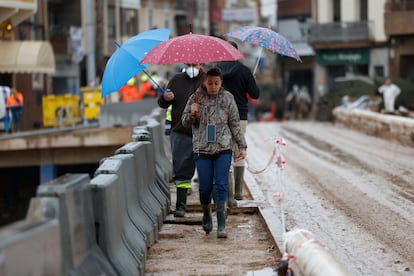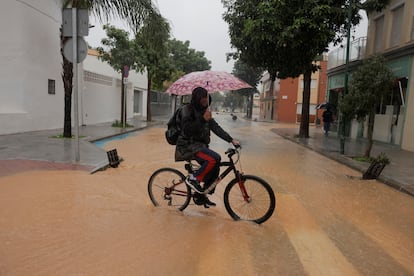Storms in Spain head for western Andalusia after lashing Málaga and Valencia
No fatalities were reported as authorities issued alerts and residents took precautionary measures following the deadly flash floods of two weeks ago


After leaving torrential amounts of rain in Málaga, Tarragona and Valencia, on Thursday the second major storm to hit Spain in the space of two weeks continued its slow path towards the southwest, en route to western Andalusia. By noon the showers had eased up on the Mediterranean coast, parts of which had been under a red weather alert.
No fatalities have been reported so far, in stark contrast with the more than 200 deaths that occurred on October 29, almost all in Valencia province, where a record deluge caused waterways to overflow, creating rivers of mud and debris that dragged people to their death as they sat in their cars or even, in some cases, inside their own houses. Besides the unprecedented human toll, the weather event destroyed infrastructure and homes, with the final cost expected to soar into tens of billions of euros. It also triggered a political dispute over who was in charge of warning citizens that day. Thousands of volunteers stepped in to help struggling residents with the cleanup effort.
On Wednesday, the city of Málaga recorded 142 mm of rainfall. All railroad access to the Andalusian city was cut off, and there were numerous road cuts. Health centers shut down, parts of Clínico Hospital were flooded, and most businesses pulled down their shutters. Across the province, over 4,200 people were evacuated from six municipalities. As it turns out, this Thursday marks the 35th anniversary of the worst flooding in Málaga’s recent history, which took place in 1989 and claimed six lives.

Valencia going back to normal
The city of Valencia was slowly going back to normal on Thursday morning, after the red weather alert issued by the national metereology agency Aemet was brought down to orange, the second level in a scale of three. The day before, citizens largely followed the safety instructions issued by authorities to prevent further tragedies in an area hard hit by the flash floods of October 29. The streets of this normally bustling city of 800,000 inhabitants were deserted from 9 p.m. in scenes reminiscent of the Covid lockdowns.
By Thursday morning the situation had started to change. While all the schools and some businesses remained closed, others began to open their doors as the day progressed. “For us it is turning out to be a bad day. Many people have stayed at home and are working from there, and there is no school today, which always means a lot of rides. It reminds me of the pandemic, although it’s not as bad,” said cab driver José Fernández, 47, before picking up Yolanda Muñoz, 50, at the stop on Avenida del Puerto. “I have no choice but to go to the health center to renew my sick leave,” explained the woman.
In the towns and villages that were especially hard hit by the October 29 flooding, residents were particularly anxious about what this second round of storms might bring. After a night of rain that was not as intense as expected, the residents of Paiporta say that on Wednesday the ravine known as Barranco del Poyo — which caused considerable damage last time around after filling up with water and overflowing — only had a thin thread of water. Now the flow is higher. “There were 20 minutes of intense downpour, and then it rained lightly. The ravine now brings what it has always brought, the normal amount of water after heavy rains,” says Manuel Tarazona, 53.
In Aldaia, the 30 tons of sandbags that local officials stacked up preventively on Wednesday to act as a retaining dike near the ravine of La Saleta did their work, preventing material damage. “They have been fundamental,” said the mayor, Guillermo Luján. Rainfall was intense in this town at various times of the night.
Political life was also on hold Thursday after the regional premier of Valencia, Carlos Mazón of the conservative Popular Party (PP), pushed back to Friday the plenary session of the regional assembly in which he is expected to provide explanations about his highly questioned management of the emergency two weeks ago.
Sign up for our weekly newsletter to get more English-language news coverage from EL PAÍS USA Edition
Tu suscripción se está usando en otro dispositivo
¿Quieres añadir otro usuario a tu suscripción?
Si continúas leyendo en este dispositivo, no se podrá leer en el otro.
FlechaTu suscripción se está usando en otro dispositivo y solo puedes acceder a EL PAÍS desde un dispositivo a la vez.
Si quieres compartir tu cuenta, cambia tu suscripción a la modalidad Premium, así podrás añadir otro usuario. Cada uno accederá con su propia cuenta de email, lo que os permitirá personalizar vuestra experiencia en EL PAÍS.
¿Tienes una suscripción de empresa? Accede aquí para contratar más cuentas.
En el caso de no saber quién está usando tu cuenta, te recomendamos cambiar tu contraseña aquí.
Si decides continuar compartiendo tu cuenta, este mensaje se mostrará en tu dispositivo y en el de la otra persona que está usando tu cuenta de forma indefinida, afectando a tu experiencia de lectura. Puedes consultar aquí los términos y condiciones de la suscripción digital.
More information
Archived In
Últimas noticias
Most viewed
- Reinhard Genzel, Nobel laureate in physics: ‘One-minute videos will never give you the truth’
- Oona Chaplin: ‘I told James Cameron that I was living in a treehouse and starting a permaculture project with a friend’
- Pablo Escobar’s hippos: A serious environmental problem, 40 years on
- Why we lost the habit of sleeping in two segments and how that changed our sense of time
- Charles Dubouloz, mountaineering star, retires at 36 with a farewell tour inspired by Walter Bonatti










































